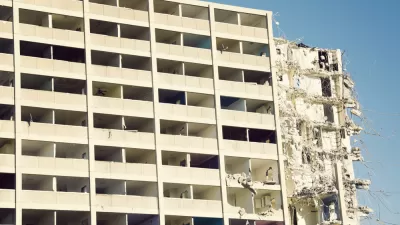With the demolition of notorious high-rise housing projects such as Cabrini-Green over the last decade and a half, Chicago became a model for a new approach to public housing. A new study tracks former high-rise residents to see how they've fared.
As the Chicago Housing Authority (CHA) prepares to release a revised version of its 12-year-old Plan for Transformation - "the largest, most ambitious redevelopment effort of public housing in the United States" - a new study by the Urban Institute of 381 families that once lived in the Madden-Wells and Dearborn housing complexes seeks to examine just how successful that influential plan has been.
According to , "Public housing residents in Chicago are marginally better off today than when they lived in the high-rise towers that have since been torn down, though more social services are needed to prevent a backslide, a study scheduled to be released Monday finds."
"Continuing problems with poverty and crime in their new neighborhoods point to a potentially dark future for many of those nearly 16,000 families, particularly children, the report by the Washington-based Urban Institute says."
What the study seems to make clear is that more than a change of scenery is required to improve people's lives.
"You still have a lot of people with very severe health problems, low levels of employment, lots of criminal justice involvement, all the kinds of things that they had before," Susan Popkin, the lead researcher in the study said. "Where we saw the improvements in terms of people's mental health, physical health and employment was when the housing was coupled with very intensive supportive services for a subset of residents."
Another obstacle: despite the goal of the CHA to move public housing families into "areas of opportunity" that are socially and economically diverse, "just seven of the 381 families tracked by researchers live in areas which fit that category."
FULL STORY: Study: CHA residents marginally better off than when living in high-rises

Alabama: Trump Terminates Settlements for Black Communities Harmed By Raw Sewage
Trump deemed the landmark civil rights agreement “illegal DEI and environmental justice policy.”

Study: Maui’s Plan to Convert Vacation Rentals to Long-Term Housing Could Cause Nearly $1 Billion Economic Loss
The plan would reduce visitor accommodation by 25% resulting in 1,900 jobs lost.

Why Should We Subsidize Public Transportation?
Many public transit agencies face financial stress due to rising costs, declining fare revenue, and declining subsidies. Transit advocates must provide a strong business case for increasing public transit funding.

Paris Bike Boom Leads to Steep Drop in Air Pollution
The French city’s air quality has improved dramatically in the past 20 years, coinciding with a growth in cycling.

Why Housing Costs More to Build in California Than in Texas
Hard costs like labor and materials combined with ‘soft’ costs such as permitting make building in the San Francisco Bay Area almost three times as costly as in Texas cities.

San Diego County Sees a Rise in Urban Coyotes
San Diego County experiences a rise in urban coyotes, as sightings become prevalent throughout its urban neighbourhoods and surrounding areas.
Urban Design for Planners 1: Software Tools
This six-course series explores essential urban design concepts using open source software and equips planners with the tools they need to participate fully in the urban design process.
Planning for Universal Design
Learn the tools for implementing Universal Design in planning regulations.
Smith Gee Studio
Alamo Area Metropolitan Planning Organization
City of Santa Clarita
Institute for Housing and Urban Development Studies (IHS)
City of Grandview
Harvard GSD Executive Education
Toledo-Lucas County Plan Commissions
Salt Lake City
NYU Wagner Graduate School of Public Service




























